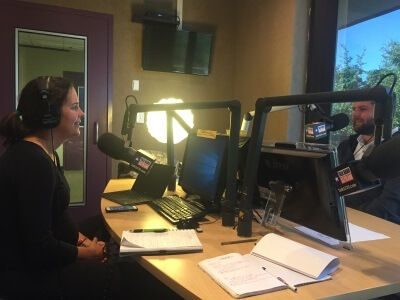Episode 25 | November 5, 2018
WattTime aims to increase energy choice and automate emissions reductions with just two lines of code. Katie Ryan, Director of Partnerships, explains how their simple solution can increase renewable energy on the electric grid and operate more efficiently.
#GOTV PSA: It’s our civic responsibility to choose our representatives, and Mid-Term Election Day is tomorrow, Tuesday, November 6th! Katie says it best: “I just hope that everybody exercises their freedom to vote.”
From Hotdogger to Sustainability Maven
Katie Ryan’s leadership in sustainability and communications, most recently as the Director of Partnerships for WattTime, has its roots on the Oscar Mayer Wienermobile. Engaging with communities while traveling the country as a hotdogger led her into a communications and public relations career, serving clients in education technology and other fields. Her interest in energy was sparked when she ran PR for Green Mountain Energy, a 100 percent renewable electricity retailer, and then joined the sustainability team at parent company NRG, which set aggressive sustainability goals such as a 90 percent reduction in carbon emissions.
“I just really became enamored with the energy industry,” Katie says. “It’s a powerful place to reach scale when it comes to addressing important issues like climate change.”
Cleaner Energy Through Energy Choice
She joined WattTime as the Director of Partnerships this year to continue her focus on creating impact at scale. “The thing that’s most important to me in sustainability is how can there be systemic change,” she continues. “The work that we’re doing at WattTime is centered around giving people choice in choosing cleaner energy.”
It starts with measuring the emissions associated with the specific power plant that delivers the electricity we use from the grid at any given time in any given place. From there, it is possible to automate our variable-use devices and appliances to optimize for environmental impact and cost.
“70 percent of our devices don’t actually need electricity constantly. They are flexible in their energy use,” notes Katie. “What we’ve done at WattTime is we’ve taken all of those algorithms and machine learning capabilities and turned them into two really simple lines of code that any smart device can implement right away, and it optimizes to choose when cleaner energy is available versus dirtier energy in a way that you wouldn’t even notice. It’s kind of amazing, but it really doesn’t impact cost or comfort or functionality.”
For example, your refrigerator just needs to run a few minutes every hour to keep its contents cold. It doesn’t really matter which minutes in that hour that the refrigerator is using power. At any given moment, WattTime knows if the electricity usage would cause a coal plant to fire up to meet the demand and can predict if a surplus of wind energy is about to hit the grid. Then it can direct the appliance to turn on when the grid is cleanest.
By avoiding the curtailment of renewable energy sources, Katie says that we can avoid wasting clean energy from wind energy and solar power generation facilities. “Those small adjustments make a big difference.”

Katie shows us a demonstration of WattTime using a lamp she brought to our studio. She explains: “I’ve taken a smart plug that has a signal from WattTime monitoring what is going on right now in Austin, Texas. It is telling the lamp when is a good time to be on and when is a good time to not run. WattTime can do a variety of different on-off signals, and the current signal that we have is really conservative. This smart plug is being told to turn on for at least five minutes out of every 15 minutes. If the light goes out, it means that coal would be the next power plant to come on to keep this device running.”
As McKay notes, this lamp is a bit like the canary in the coal plant. Fortunately, the light stays on, indicating that our power mix at this moment is pretty clean!
Change at Scale for the Future
As adoption of smart devices continue to grow worldwide, WattTime sees the potential for their solution to achieve significant scale without a significant investment or inconvenience to energy consumers. “In an ideal world,” says Katie, “you’ll purchase a smart thermostat. It’ll be optimized for emissions reduction and you won’t have to think twice about it, and because it’s two lines of code it doesn’t change the cost. You won’t have a consumer impact to having those two lines of code.”
We discuss a couple of case studies using WattTime’s technology:
- Google is the largest corporate purchaser of renewable energy in the country. The company has evolved from purchasing renewable energy credits (RECs) to building onsite generation, and it now uses WattTime to heatmap the greenhouse gas emissions from each of its data centers in real time. The immediacy and actionability of this data is a major improvement for Google and will hopefully inspire other companies to follow its lead.
- WattTime is partnering with demand response aggregators and utilities to combine demand response with its Automated Emissions Reduction solution. In addition to helping the utility avoid peaker plant production and excessive energy prices during periods of high electricity demand, the partnership can “tune” the household’s HVAC all year round to improve the environmental benefit.
This technology is a great fit for companies and organizations with sustainability goals, utilities, demand response aggregators, and smart device makers, all of whom can learn more at WattTime.org. As a mission-based non-profit, WattTime operates with a sustainable business model and is motivated to ensure wide adoption of the solution. “Our technology costs money, but our goal is to make sure that it scales,” Katie says. “We like to work with everybody and we just want it to work, which makes it really nice to work with us.”
For more information about Freedom Solar and our home solar installation or commercial solar installation, please contact us!
LINKS AND RESOURCES
- Green Mountain Energy Company
- NRG
- WattTime
- Google’s Sustainability Blog and White Paper on how Carbon Heat Maps are furthering their 100 percent renewable energy goal
- Case Study on WattTime and Building Clouds demand response partnership for UC Berkeley
Tun in for our next episode with Leigh Christie, a lawyer, an entrepreneur, nonprofit leader and the Senior Vice President of Global Technology and Innovation on how to ensure sustainable and healthy economic growth.
